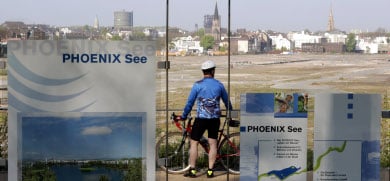Twenty years ago, the women in Dortmund living around the Phoenix industrial site would have to take their laundry inside before six o’clock if they didn’t want their clothes turned black as the furnace ovens from coke and steel factories would open to release grime and ashes into the air.
The sky turned a glowing red from the fackel, a long torch-like chimney in which gases from steel production burned.
At the sound of the siren, hundreds of workers, their faces black from coal stains, would march up Hermannstrasse from the Phoenix factories to meet their wives and children at home. Their faces and lungs were dirty, but most were happy. They had secure jobs and good salaries. Unemployment was almost inexistent.
Today, above Hermanstrasse in the Hörde district of Dortmund, where Europe’s steel industry was born, the red glow is gone, and so are the factories. The facades of the buildings, once black, are now colorful and clean.
“In the last years, a quite massive change has happened. Since the loss of the heavy industry the pollution is much lower,” said Timo Bouerdick, a 28-year-old media sciences student in Dortmund.
The city is now known being trumpeted as the “green metropolis” of the German state of North Rhine-Westphalia because nearly half of its land consists of leafy spaces. But getting rid of the heavy industry, and by extension, of the heavy pollution, didn’t come without consequences.
The price of clean
The district of Hörde these days has an unemployment rate of roughly 18 percent – far above the German national average of 8 percent. So reliant on the coal and steel industries of the Phoenix site for work, it’s now one of Dortmund’s areas hardest hit by the structural changes created by the disappearance of the heavy industry from the Ruhr Valley.
“People in Hörde are frustrated because there is a high unemployment rate, especially since the Hoesch steel mill closed down in 2001,” explained Laura Kasprowiak, a journalist from Dortmund’s local 91.2 radio station. She has spoken to many locals while documenting the development of the Phoenix project.
Between 1960 and 2003, Dortmund lost 80,000 jobs in the coal and steel industries – that Hoesch mill alone employed 40,000 people in 1966 – after German coal had become too expensive compared to imported fuel.
But there is hope for an economic revival. The Phoenix site, where eight major industrial production sites once stood, is now literally being transformed into a new city from scratch. There will be 900 new housing units and “up to 10 000 new jobs,” according to the city. The east part of Phoenix will even boast an artificial lake big enough for people to go sailing.
“150 years of steel and coal are gone. We have to accept that,” said 69-year-old Hans Pingel, the president of an association that represents the interests of Hörde’s shopkeepers and business owners. “It’s a great thing for us that a lake of 28 acres will be here.”
When steel production on Phoenix stopped completely in 2001, Dortmund had two huge sites partly encircling Hörde available for development. Three furnace ovens as well as the Kaiserstuhl coking plant were disassembled and sold to China.
The city’s booster quickly came up with the idea of turning the vacant space into a technology park and a high-quality residential district with a large artificial lake. The excavation started in 2005 and the area will be flooded in 2009.
“People thought it was crazy,” said Ulrich Spangenberg, Hörde’s honourary mayor. “But this is really happening, and it will be a huge lifestyle improvement for people. For the whole area, it will be an example of how structural change can be successful.”
Phoenix is divided into eastern and western parts – with Hörde in the middle. The east will be dedicated to housing, recreation around the lake, and a few small businesses. The western section will become a technology park meant to attract businesses of the future.
Each of Phoenix’s sections is budgeted to cost €190 million. One third of the funding for the residential area will come from public coffers, whereas the business area will see the European Union and German government subsidies cover half of the costs.
But some residents are concerned the jobs created will be given to well-educated outsiders from the IT industry instead of locals. Others, like Alexandra Stelzer, a middle-aged housewife, are worried about rising real-estate prices.
“There are so many empty buildings in the city which are unused. They are ripping them down. They could let homeless people live there or put the businesses there,” Stelzer, insisted.
Changing the Ruhr’s image
But for the boosters of the Phoenix project, one of the biggest hurdles to overcome are people’s perception of the Ruhr Valley because of its long history as a dirty industrial pit. “People can’t imagine you can do business here,” Paul Blanke-Bartz from the city’s economic development agency said. “We are trying to create a new urban environment. In Phoenix, there will be a completely new landscape of jobs, work, technology, business and services. Everything will be new, with up-to-date standards.”
Spangenberg hopes Phoenix will bring an “explosion of development” and turn into a leading technology centre in Europe.
To attract researchers, innovators and young professionals, Phoenix will have what Blanke-Bartz calls the “incubator,” where students who have just graduated will be able to rent, at very affordable rates, specialized, ultra-clean sterile rooms necessary for developing new micro technologies. Such facilities would otherwise be out-of-reach for young entrepreneurs just starting out in the field.
How much the ordinary denizens of Hörde will be able to benefit from the grand plans remains to be seen. But at least for now, black laundry is history.



 Please whitelist us to continue reading.
Please whitelist us to continue reading.